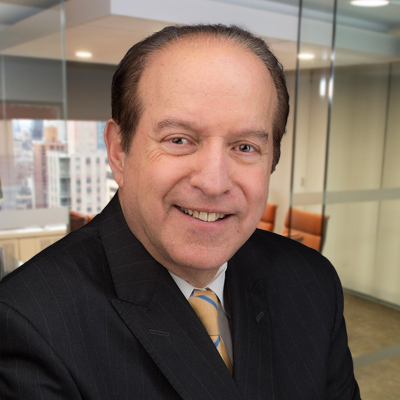My Fashion (Legal) Odyssey: Part 2
7th Avenue in the '80s, Fashion Would Never Be The Same

The year is 1983.
There is no internet. There are no cellphones. The buildings in the garment center are filled with fashion companies owned by the people who built them, and not by brand-owner companies that only license them out.
I had relocated my work life from a major law firm on Wall Street, to the offices (and showroom) of the now iconic Sergio Valente designer jeans company at 498 Seventh Avenue. Seventh Avenue was then teeming with all the people that made the garment center tic.
The Eighties was my favorite decade. I liked the dramatic, forties-inspired, big‑shouldered jackets for both men and women, the connection between art and fashion, in my case in ties and jackets of fabric that resembled abstract paintings, and the wide flowing pants.
And, of course, the music. Though I am more of a jazz fan, I loved Eighties pop music!
Sergio was a business marriage of two groups of partners: Hong Kong jeans factory owners and New York business operators. The strengths, different cultures and talents of those two groups led to Sergio’s meteoric growth but also created tensions.
Sergio’s had a cast of colorful characters, especially an entertaining salesman who never forgot his high school years. He was a big hit with the buyers. An astrology enthusiast, he told every buyer that they would have three great years coming up. His forecasts for me were less positive! I learned a great deal at Sergio about the fashion business!
My first major task concerned a long-standing opposition in the U.S. Trademark Office to application to register the trademark “Sergio Valente.” The trademark opposition was filed by a Mr. Sergio Valente who owned the most fashionable hair salon in Rome. He claimed my company had stolen his name. I have no knowledge and no comment on that subject. My company claimed it had coined the trademark as a composite of the surnames of two cousins of the company’s President. One cousin, according to our President, was called Sergio, while the other was called Valentin. I have no comment on that subject either other than to say that I have never known before or since a Jew named Valentin.
A surprising event caused the trademark opposition to be settled. Mr. Valente filed a lawsuit in New York State Court against my company seeking an injunction to stop my company from selling any jeans using the name “Sergio Valente”. His law firm was Saxe, Bacon and Bolan, the firm of the notorious Roy Cohn, former Joseph McCarthy staffer and mentor to Donald Trump. They sought this injunction despite the fact that hundreds of millions of dollars of jeans had been openly sold under the “Sergio Valente” trademark by my company with nary a complaint from Mr. Valente. I noted this point in my court papers opposing the injunction motion. The judge called me and Mr. Valente’s lawyer into a small room behind the courtroom. He turned to my opponent (an associate in Cohn’s firm) and said to him “Mr. ____________, you are full of shit.” The judge denied the injunction motion.
The trademark opposition was promptly settled thereafter, with Mr. Valente obtaining the right to open a hair salon in Bergdorf Goodman (which was always his goal), and my company receiving the right to register its trademark.

To my mind, Sergio and the other designer jean companies democratized branding, and not just for jeans. Before these brands, consumers needed to spend what was to them a lot of money to create a personal connection with a cool brand. Now the products of these cool brands were readily accessible to the average consumer. And Sergio’s products were cool. The fit and make were excellent. They were one of the first companies to bring Jackson Pollack-esque acid wash jeans to the U.S. Sergio would go on to make striped jeans, promoted by a zebra image on a billboard on the LIE near the midtown tunnel! It was all exciting and innovative.
Another monumental shift was happening during my time at Sergio. Garment production was migrating overseas, especially to Asia. A truly huge change. Taking production offshore to Asia would, among other things, typically result in lower production costs but also result in longer lead times needed to timely complete orders. The industry was transforming and I witnessed it first-hand.
I tried, in my own small way, to initiate another change, the marriage of fashion and entertainment.
The business of Sergio was built on the annual expenditure of millions of dollars on broadcast (not cable!) television advertising which featured the brand’s catchy jingle “Uh-oh Sergio”.
I was summering for the first time in the Hamptons in a “share” house. I read in one of the Hampton weeklies about a singer who would be performing at Bay Street, an underground disco then in Sag Harbor. Something about this performer intrigued me. So off I went to the club on Saturday night. I came away convinced that I had seen a soon-to-be superstar, a superstar who would appeal greatly to Sergio’s customers, and could be the face and voice of great musical tv ads. On Monday, I told the company about the budding superstar.
They were underwhelmed. What did Charles know? He was only a lawyer. No connection was made.

The performer was Madonna!
Slowly, but surely, the fashion-entertainment connection would become a cornerstone of the industry.
My stint at Sergio lasted four years. The tensions between the Hong Kong and New York partners apparently caused them to break apart. I returned to private practice, where I have continued to this day to represent fashion companies and designers.
My Next Article: Race and Fashion — The Emergence of the Urban Brands
Meet the Author

Charles Klein, Esq. Charles Klein is a partner and chair of the Fashion Law Group of Davidoff Hutcher & Citron LLP, a mid-size, midtown Manhattan law firm. DHC has been helping clients solve challenging problems since 1975.
Although he handles a wide variety of business law matters for clients, Mr. Klein’s practice is particularly focused on the fashion, accessories, and home industries, where he helps his clients build their businesses, obtain protection for their intellectual property, protect their brand assets, and negotiate their license agreements and other contracts.


